Open fractures are bone breaks that tear through soft tissue and the skin. In some open fractures, the soft tissue wound is far from the actual bone break. These fractures are dangerous as they can lead to substantial blood loss and can become infected easily. These types of bone fractures usually occur after a car accident or a serious fall. If you or a member of your family have been injured because of the negligent actions of another, our national personal injury lawyers are ready to protect your valuable legal rights. Our personal injury law firm is committed to recovering full compensation for your injuries, pain, suffering, property damage, and other damages.
Free Consultation. Attorneys Available Now.
To learn about your legal rights and the options you have to make a financial recovery, contact Montlick Injury Attorneys for your free, friendly consultation. Reach us Nationwide 24/7 at 1-800-LAW-NEED® (1-800-529-6333) to speak to an attorney for free and without obligation.
The Initial Treatment of Compound Fractures
When a patient arrives at the emergency room and they have an open fracture, the emergency room physician may perform a physical examination of the patient’s injuries. The emergency room physician may also order x-rays to examine the bone fracture, make surgical measurements, and determine the best surgical treatment. Moreover, the patient will be given intravenous antibiotics to prevent the risk of infection. In some cases, the patient will be given a tetanus booster shot when the patient has not received a tetanus booster in the past five years. In some cases, a general or orthopedic surgeon will be called in to perform the surgery. In those circumstances, the emergency room doctor will place a sterile bandage on the wound and stabilize the limb until the patient has surgery.
Determining the Severity of an Open Bone Fracture
- The following factors help doctors determine the severity of a compound fracture:
- The quantity of bone fragments.
- Bone fragment size.
- The amount of soft tissue damage.
- The injury location.
- The amount of circulation in the injured area.
The Potential Complications of Compound Fractures
The most serious medical complications that can emerge with open fractures can include:
Compartment Syndrome: Compartment Syndrome is a painful medical condition involving increased pressure within the arm muscle, or leg, causing a loss of localized circulation. An immediate surgical procedure is generally required to reduce the pressure built up. Should the condition be left untreated, there may be permanent tissue damage and/or a loss of function.
Infection: One of the most serious medical complications concerning bone fractures is infection. Infection is caused by bacteria coming into contact with the wound during the injury. Infection in the wound can cause a disturbance in the healing process and, if left untreated, death. Infection of the bone can lead to additional surgical procedures.
Nonunion: When there is a lot of vascular damage in the wound, the fractured bone may not heal properly. Additional surgical procedures may be necessary when the bone fracture does not heal properly. In the most severe cases, internal fixation, bone grafting, or amputation may be required.
How to Treatments Open Fractures
Treating open fractures is not easy and requires experienced surgeons to properly mend the bones. Prior to surgery, the wound is properly and thoroughly cleaned to reduce the possibility of infection. The surgery is performed under general or regional anesthesia, and that treatment typically includes:
Irrigation and Debridement: The most important step in fixing an open fracture is the debridement of the wound. Debridement involves removing foreign material and necrotic tissue from the injured area. Oftentimes, the surgeon will open up the wound to better inspect and debride the wound. The wound is then irrigated with saline solution to kill bacteria and promote the healing process. Once the wound has been properly cleaned, the surgeon will examine the fracture and stabilize the bones.
Internal Fixation: To help the bone heal properly, the surgeon may place titanium rods, plates, and screws inside or along the surface of the bone break. These implants are designed to hold the bone together throughout the healing process. If there is minimal skin or tissue damage and the injury area is clean, internal fixation may be recommended.
External Fixation: In some open bone fractures, the treating physician might decide to use external fixation to repair the fractured bone. In these cases, there are no permanent implants used. External fixation is recommended in serious open fracture cases. External fixation uses metal bars or carbon fiber to attach to the pins and screws that will project out of the skin and support bone placement. External fixation provides better stabilization for the fracture.
Typically the external fixator is used until the treating physician decides it is safe to perform an internal fixation surgical operation or until the healing process has finished. A second surgical procedure then removes the components of the external fixator after the bone break is healed.
Dressing: Bone breaks with open wounds often require sterile bandages to reduce the chances of infection. The semipermeable dressing seals up the wound until a permanent closure is performed. Before the wound is sealed, antibiotic beads are inserted to provide antibiotics.
Wound Grafts: After some healing has occurred, the doctor applies permanent wound coverage such as a skin graft. The skin graft is often harvested from a different area of the body.
Physical Therapy Following a Bone Fracture Repair
Successful treatment does depend on the patient’s adherence to treatment instructions. One of the most important parts of the healing process is physical therapy. Physical therapy restores muscle strength, joint motion, and flexibility. A physical therapist will provide the patient with a rehabilitation plan best suited to their individual needs and treatment plan.
Contact Our Open Fracture Attorneys Today
When someone has sustained a compound fracture in any type of accident, they may be qualified to receive substantial monetary compensation. This compensation could include lost earnings, past and future medical bills, loss of future earnings, property damage, physical therapy, pain and suffering. If you or a loved one sustained a compound fracture caused by the negligent actions of another, speak with our personal injury lawyers.
We Know What It Takes To Win!®
If you or a loved one suffered the loss of a loved one in an accident, contact Montlick Injury Attorneys, for your free consultation today. Our law firm has been representing those who suffer serious injuries or lost a loved one in an accident for over 39 years. Our trial attorneys have recovered billions of dollars for our personal injury clients through negotiated settlements, litigation/lawsuits, settlement of lawsuits, jury verdicts, mediation, and arbitration awards.
Please visit our Montlick Injury Attorneys reviews to see what our clients have to say about our commitment to exceptional service.
No matter where you are located, our attorneys are just a phone call away, and we will even come to you. Call us nationwide 24 hours day/7 days a week for your Free Consultation at 1-800-LAW-NEED® (1-800-529-6333), or simply dial #WIN® (#946) from your mobile phone. You can also visit us online at Montlick.com and use our Free Case Evaluation Form or Free 24-hour live chat.
Source:
—
Montlick Injury Attorneys
17 Executive Park Dr NE
Atlanta, GA 30329, United States
Hours: Open 24 hours
Phone: (404) 529-6333
Toll Free: (800) 529-6333
Plus Code: RMH6+38 Atlanta, Georgia, USA
Directions


